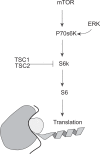Targeted therapy in the treatment of malignant gliomas
- PMID: 20616900
- PMCID: PMC2886330
- DOI: 10.2147/ott.s3027
Targeted therapy in the treatment of malignant gliomas
Abstract
Malignant gliomas are invasive tumors with the potential to progress through current available therapies. These tumors are characterized by a number of abnormalities in molecular signaling that play roles in tumorigenesis, spread, and survival. These pathways are being actively investigated in both the pre-clinical and clinical settings as potential targets in the treatment of malignant gliomas. We will review many of the therapies that target the cancer cell, including the epidermal growth factor receptor, mammalian target of rapamycin, histone deacetylase, and farnesyl transferase. In addition, we will discuss strategies that target the extracellular matrix in which these cells reside as well as angiogenesis, a process emerging as central to tumor development and growth. Finally, we will briefly touch on the role of neural stem cells as both potential targets as well as delivery vectors for other therapies. Interdependence between these varied pathways, both in maintaining health and in causing disease, is clear. Thus, attempts to easily classify some targeted therapies are problematic.
Keywords: EGFR; HDAC; Ras; angiogenesis; glioma; mTOR.
Figures





Similar articles
-
Emerging therapies for malignant glioma.Expert Rev Anticancer Ther. 2007 Dec;7(12 Suppl):S29-36. doi: 10.1586/14737140.7.12s.S29. Expert Rev Anticancer Ther. 2007. PMID: 18076315 Review.
-
Emerging targeted therapies for glioma.Expert Opin Emerg Drugs. 2016 Dec;21(4):441-452. doi: 10.1080/14728214.2016.1257609. Epub 2016 Nov 14. Expert Opin Emerg Drugs. 2016. PMID: 27809598 Review.
-
Present and potential future adjuvant issues in high-grade astrocytic glioma treatment.Adv Tech Stand Neurosurg. 2009;34:3-35. doi: 10.1007/978-3-211-78741-0_1. Adv Tech Stand Neurosurg. 2009. PMID: 19368079 Review.
-
Targeted molecular therapy of malignant gliomas.Curr Neurol Neurosci Rep. 2005 May;5(3):186-97. doi: 10.1007/s11910-005-0046-8. Curr Neurol Neurosci Rep. 2005. PMID: 15865884 Review.
-
Targeted molecular therapy of malignant gliomas.Curr Oncol Rep. 2006 Jan;8(1):58-70. doi: 10.1007/s11912-006-0011-y. Curr Oncol Rep. 2006. PMID: 16464405
Cited by
-
Assessing current therapeutic approaches to decode potential resistance mechanisms in glioblastomas.Front Oncol. 2013 Mar 19;3:59. doi: 10.3389/fonc.2013.00059. eCollection 2013. Front Oncol. 2013. PMID: 23516171 Free PMC article.
-
Integration of genomics, high throughput drug screening, and personalized xenograft models as a novel precision medicine paradigm for high risk pediatric cancer.Cancer Biol Ther. 2018;19(12):1078-1087. doi: 10.1080/15384047.2018.1491498. Epub 2018 Oct 9. Cancer Biol Ther. 2018. PMID: 30299205 Free PMC article.
-
Signal transduction molecule patterns indicating potential glioblastoma therapy approaches.Onco Targets Ther. 2013 Nov 29;6:1737-49. doi: 10.2147/OTT.S52365. eCollection 2013. Onco Targets Ther. 2013. PMID: 24348050 Free PMC article.
-
Mitochondrial KATP Channels Control Glioma Radioresistance by Regulating ROS-Induced ERK Activation.Mol Neurobiol. 2015 Aug;52(1):626-37. doi: 10.1007/s12035-014-8888-1. Epub 2014 Sep 24. Mol Neurobiol. 2015. PMID: 25249341
References
-
- Louis DN, Ohgaki H, Wiestler OD, Cavenee WK. WHO Classification of Tumors of the Central Nervous System. 4th edition. Lyon, France: International Agency For Research on Cancer; 2007.
-
- Wickstrand CJ, McClendon RE, Friedman AH, Bigner DD. Cell surface localization and density of the tumor-associated variant of the epidermal growth factor receptor, EGFRvIII. Cancer Res. 1997;57(18):4130–4140. - PubMed
-
- Pelloski CE, Ballman KV, Furth AF, et al. Epidermal growth factor receptor variant III status defines clinically distinct subtypes of glioblastoma. J Clin Oncol. 2007;25(16):2288–2294. - PubMed
LinkOut - more resources
Full Text Sources
Research Materials
Miscellaneous

